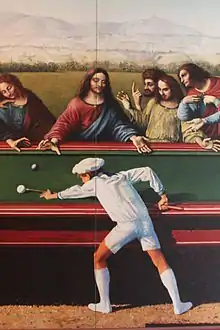Rudolf Hausner
Rudolf Hausner (4 December 1914, Vienna – 25 February 1995, Mödling) was an Austrian painter, draughtsman, printmaker and sculptor. Hausner has been described as a "psychic realist" and "the first psychoanalytical painter" (Gunter Engelhardt).

Early life
Of Jewish origins,[1] Hausner studied at the Academy of Fine Arts in Vienna from 1931 until 1936.
Following World War II
In 1944, Hausner married Irene Schmied. During the last days of the second world war he was assigned to an air defense unit. After the war, he returned to his bomb-damaged studio and resumed work as an artist. In 1946 he founded a surrealist group together with Edgar Jené, Ernst Fuchs, Wolfgang Hutter and Fritz Janschka. They were later joined by Arik Brauer and Anton Lehmden. He joined the Art-Club and had his first one-man exhibition in the Konzerthaus, Vienna. A key work of this period, It's me! (1948; Vienna, Hist. Mus.), shows his awareness of Pittura Metafisica and Surrealism in a psychoanalytical painting where the elongated being in the foreground penetrates what was apparently a real landscape, until it tears like a backdrop; another painting, Forum of Inward-turned Optics (1948; Vienna, Hist. Mus.), is evidence of his ability to depict the subject in a realist style while simultaneously overturning the laws of one-point perspective. He married Hermine Jedliczka in 1951; their daughter Xenia Hausner, also an artist, was born the same year. After working on the painting for six years, he completed his masterpiece, The Ark of Odysseus, in 1956. The Ark of Odysseus (1948–51 and 1953-6; Vienna, Hist. Mus.), depicts the hero as a self-portrait and was a precursor to the series of Adam paintings in which Hausner painted his own features.
Conflict with the Surrealists and later life
In 1957, Hausner painted his first "Adam" picture. He came into conflict with the Surrealist orthodoxy, who condemned as heretical his attempt to give equal importance to both conscious and unconscious processes. In 1959 he co-founded the Vienna School of Fantastic Realism together with his old surrealist group members: Ernst Fuchs, Fritz Janschka, Wolfgang Hutter, Anton Lehmden and Arik Brauer. In 1962, Hausner met Paul Delvaux, René Magritte, Victor Brauner, and Dorothea Tanning while traveling in Germany, the Netherlands, Belgium, and France. The 1st Burda Prize for Painting was awarded to him in 1967. In 1969, he was awarded the Prize of the City of Vienna. Shortly after, he separated from Hermine Jedliczka and moved to Hietzing together with his daughter Xenia and Anne Wolgast, whom he had met in Hamburg.
From 1966 until 1980, he was a guest professor at the Hochschule für bildende Künste Hamburg. He also taught at the Academy of Fine Arts Vienna. Among his students were Oz Almog, Joseph Bramer, Friedrich Hechelmann, Gottfried Helnwein, F. Scott Hess, Michael Engelhardt, and Siegried Goldberger. Hausner was awarded the Austrian State Prize for Painting in 1970.
Bibliography
- R. Hausner, Adam und Anima (exh. cat., Bad Frankenhausen, Panorama Mus., 1994)
References
- Steven Beller, Vienna and the Jews, 1867–1938: A Cultural History, Cambridge University Press (1990), p. 29
Sources
- Die Wiener Schule des Phantastischen Realismus (exh. cat., Hannover, Kestner-Ges., 1965)
- W. Schmied: Rudolf Hausner (Salzburg, 1970)
- V. Huber, ed.: Rudolf Hausner: Werkzeichnis der Druckgraphik von 1966 bis 1975 (Offenbach am Main, 1977)
- H. Hollander: Rudolf Hausner Werkmonographie (Offenbach am Main, 1985)